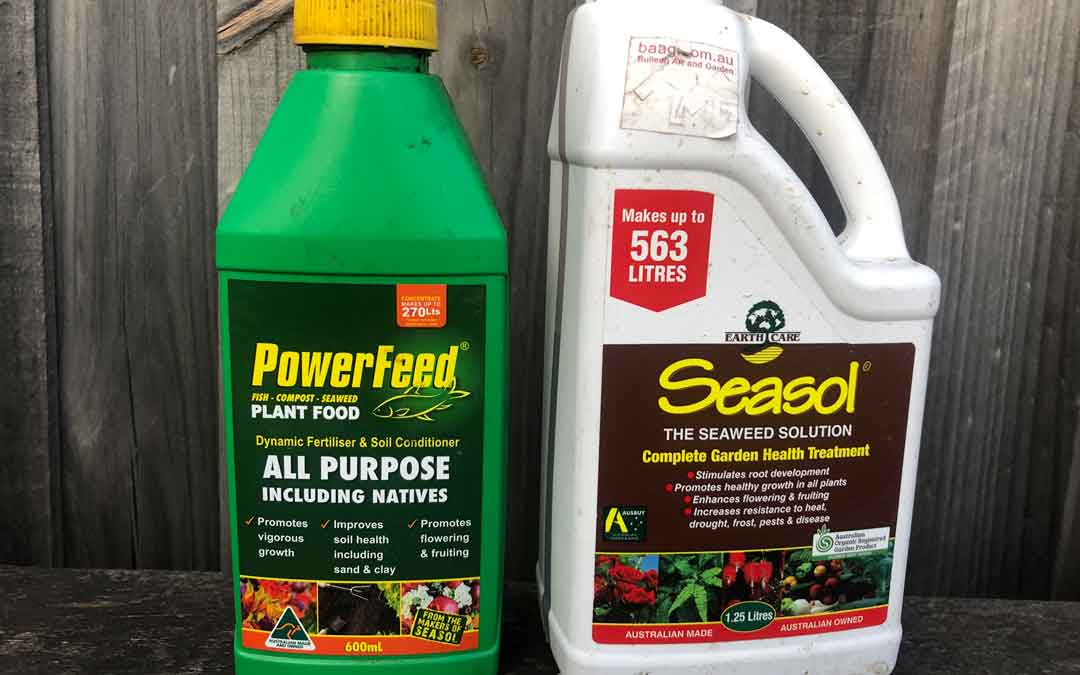Which liquid fertiliser should I use?

Which liquid fertiliser should I use?
I’m often asked questions about liquid fertilisers such as: Are all liquid fertilisers the same? Can I use them interchangeably? What’s the difference? How would I know which one to use? The short answer is that they are not all the same and they are used for different purposes. To further complicate things, you might use different types on one plant at different times in the growth cycle. Liquid fertilisers are designed to be used as sprays or diluted in a watering can or the container is attached to a hose for spraying. They are valuable because plant roots can only absorb nutrients in liquid form.
Essentially, there are 2 types of liquid fertiliser:
- Foliar sprays that contains trace elements, (also known as micronutrients) such as seaweed sprays eg Seasol and Maxicrop. Trace elements are mineral elements needed by plants in minute amounts. Some are essential for plant health.
- Nitrogen based sprays made from fish eg Charlie Carp and Powerfeed. Nitrogen contains chlorophyll which is vital for photosynthesis in plants. Photosynthesis converts the sun’s energy, water, and carbon dioxide from the air, into sugars for plants to consume.
To illustrate the different usage on one plant, let’s take garlic. First of all, the soil needs to be well prepared and fertilised before planting in March-April with such things as compost, blood and bone and well decomposed manures all of which act as a slow release food source. After the shortest day in June, until August, garlic may need additional nitrogen as it uses up what is in the soil. This will feed and strengthen the tops and roots. However if nitrogen is applied later than August, it will result in the growth of the leaves at the expense of the bulbs. Applying liquid seaweed on the other hand will result in swelling of the bulb and should be applied every 2-3 weeks from September until harvest in December.
Seaweed liquids contain complex carbohydrates, plant hormones, and trace elements in an available form. When applied appropriately, they result in:
- early flowering and fruit bearing and heavier crops
- prevention of transplant shock
- strengthening of the cells of plant walls which allows for better water delivery to the whole plant including flowers and fruit
- production of stronger roots
- protection against heat and frost stress, diseases especially soil borne diseases, and pests
- activation of compost heaps.
Nitrogen-based fish fertiliser has some advantages in common with seaweed liquids including:
early flowering and fruit bearing
- production of stronger roots
- protection against stress, diseases especially soil borne diseases, and pests.
It also makes lawns and plants greener but overuse produces leaf at the expense of fruit.
Both are excellent soil conditioners and increase beneficial microbial life in the soil. They do this more effectively than solid fertilisers because, as above, their liquid nature allows immediate uptake of nutrients through the root system. Both are also sustainable products. Seaweed is sourced from beaches (especially bull kelp) where it washes up having broken from the main plant, and fish is sourced from European carp, an invasive pest of Australian waterways, that additionally threatens native fish species.
One of the problems of trying to sort out what to use, is that manufacturers don’t make it easy. They include all ingredients on the label but with no weighting of these and most of us would not know how to assess the relative amounts for example, of trace elements or nitrogen. They also tend to present the widest range of benefits again with no weighting about the degree of effectiveness eg does a particular product produce a lot of root growth or just a little? Appropriate leaf growth or overgrowth at the expense of fruit? Each manufacturer also makes both seaweed and fish based products, so for example Seasol which sounds like a seaweed company makes Powerfeed, a fish-based product.
My best advice is to work out whether the product is seaweed-based or fish-based, what you are trying to achieve through a liquid application, choose accordingly, and then follow the instructions on the label.
Written by Robin Gale-Baker
